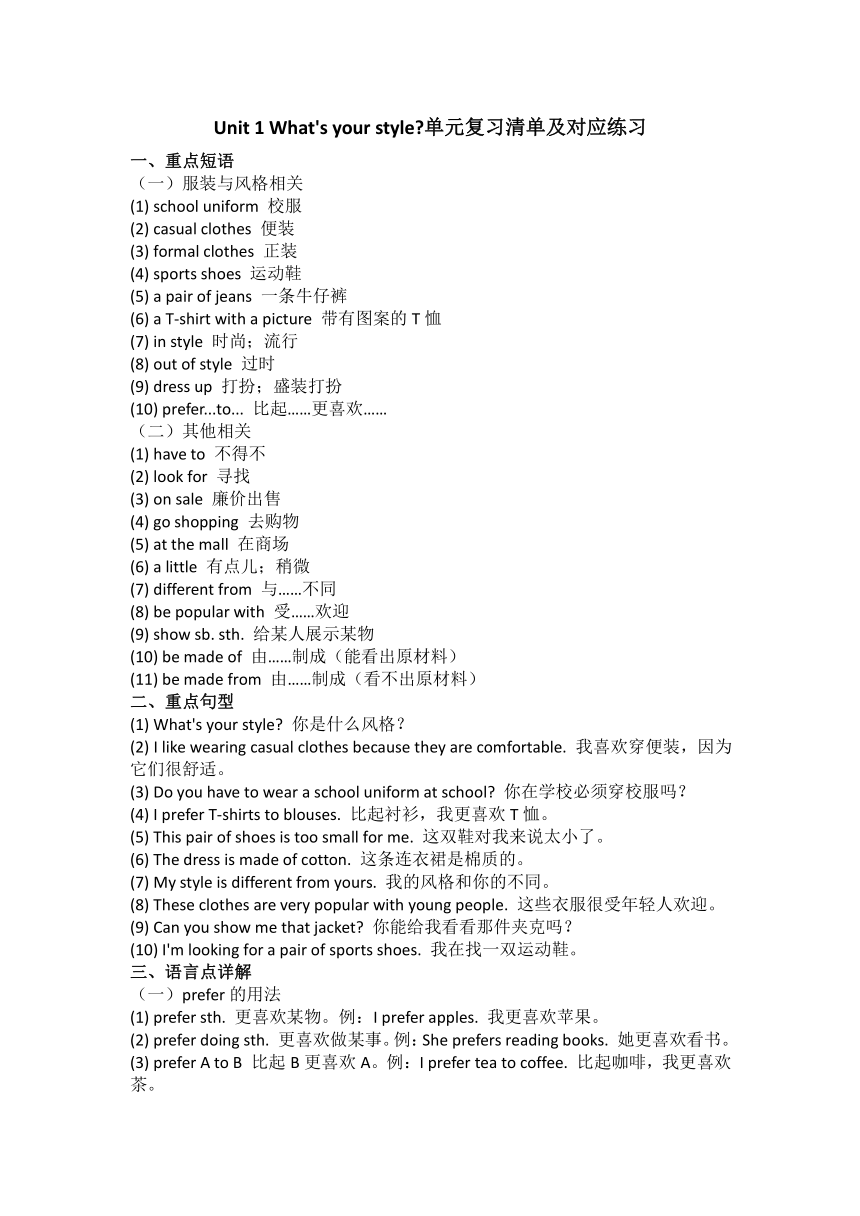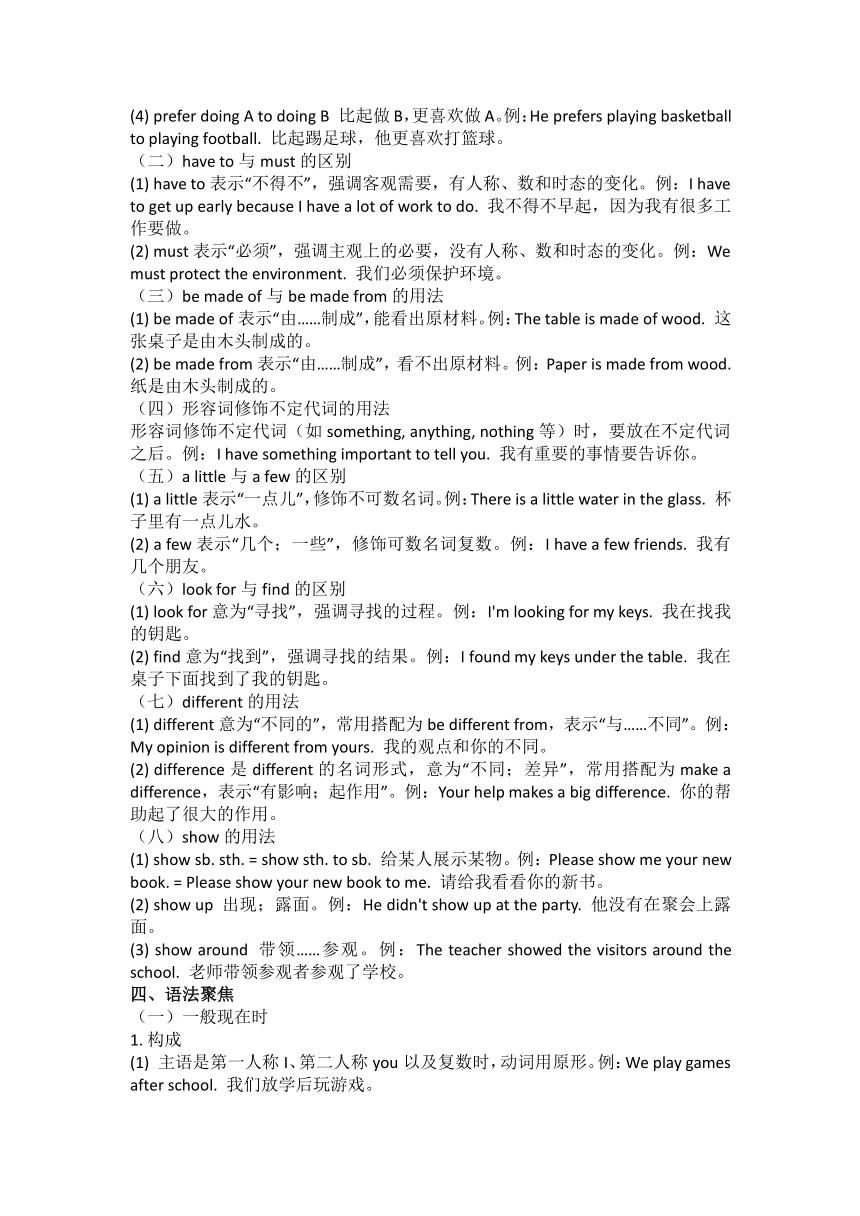Unit 1 What's your style 单元知识清单及对应练习(含答案)2024-2025学年教科版(五四学制)英语六年级下册
文档属性
| 名称 | Unit 1 What's your style 单元知识清单及对应练习(含答案)2024-2025学年教科版(五四学制)英语六年级下册 |  | |
| 格式 | docx | ||
| 文件大小 | 22.4KB | ||
| 资源类型 | 教案 | ||
| 版本资源 | 教科版 | ||
| 科目 | 英语 | ||
| 更新时间 | 2025-03-11 14:50:09 | ||
图片预览


文档简介
Unit 1 What's your style 单元复习清单及对应练习
一、重点短语
(一)服装与风格相关
(1) school uniform 校服
(2) casual clothes 便装
(3) formal clothes 正装
(4) sports shoes 运动鞋
(5) a pair of jeans 一条牛仔裤
(6) a T-shirt with a picture 带有图案的T恤
(7) in style 时尚;流行
(8) out of style 过时
(9) dress up 打扮;盛装打扮
(10) prefer...to... 比起……更喜欢……
(二)其他相关
(1) have to 不得不
(2) look for 寻找
(3) on sale 廉价出售
(4) go shopping 去购物
(5) at the mall 在商场
(6) a little 有点儿;稍微
(7) different from 与……不同
(8) be popular with 受……欢迎
(9) show sb. sth. 给某人展示某物
(10) be made of 由……制成(能看出原材料)
(11) be made from 由……制成(看不出原材料)
二、重点句型
(1) What's your style 你是什么风格?
(2) I like wearing casual clothes because they are comfortable. 我喜欢穿便装,因为它们很舒适。
(3) Do you have to wear a school uniform at school 你在学校必须穿校服吗?
(4) I prefer T-shirts to blouses. 比起衬衫,我更喜欢T恤。
(5) This pair of shoes is too small for me. 这双鞋对我来说太小了。
(6) The dress is made of cotton. 这条连衣裙是棉质的。
(7) My style is different from yours. 我的风格和你的不同。
(8) These clothes are very popular with young people. 这些衣服很受年轻人欢迎。
(9) Can you show me that jacket 你能给我看看那件夹克吗?
(10) I'm looking for a pair of sports shoes. 我在找一双运动鞋。
三、语言点详解
(一)prefer的用法
(1) prefer sth. 更喜欢某物。例:I prefer apples. 我更喜欢苹果。
(2) prefer doing sth. 更喜欢做某事。例:She prefers reading books. 她更喜欢看书。
(3) prefer A to B 比起B更喜欢A。例:I prefer tea to coffee. 比起咖啡,我更喜欢茶。
(4) prefer doing A to doing B 比起做B,更喜欢做A。例:He prefers playing basketball to playing football. 比起踢足球,他更喜欢打篮球。
(二)have to与must的区别
(1) have to表示“不得不”,强调客观需要,有人称、数和时态的变化。例:I have to get up early because I have a lot of work to do. 我不得不早起,因为我有很多工作要做。
(2) must表示“必须”,强调主观上的必要,没有人称、数和时态的变化。例:We must protect the environment. 我们必须保护环境。
(三)be made of与be made from的用法
(1) be made of表示“由……制成”,能看出原材料。例:The table is made of wood. 这张桌子是由木头制成的。
(2) be made from表示“由……制成”,看不出原材料。例:Paper is made from wood. 纸是由木头制成的。
(四)形容词修饰不定代词的用法
形容词修饰不定代词(如something, anything, nothing等)时,要放在不定代词之后。例:I have something important to tell you. 我有重要的事情要告诉你。
(五)a little与a few的区别
(1) a little表示“一点儿”,修饰不可数名词。例:There is a little water in the glass. 杯子里有一点儿水。
(2) a few表示“几个;一些”,修饰可数名词复数。例:I have a few friends. 我有几个朋友。
(六)look for与find的区别
(1) look for意为“寻找”,强调寻找的过程。例:I'm looking for my keys. 我在找我的钥匙。
(2) find意为“找到”,强调寻找的结果。例:I found my keys under the table. 我在桌子下面找到了我的钥匙。
(七)different的用法
(1) different意为“不同的”,常用搭配为be different from,表示“与……不同”。例:My opinion is different from yours. 我的观点和你的不同。
(2) difference是different的名词形式,意为“不同;差异”,常用搭配为make a difference,表示“有影响;起作用”。例:Your help makes a big difference. 你的帮助起了很大的作用。
(八)show的用法
(1) show sb. sth. = show sth. to sb. 给某人展示某物。例:Please show me your new book. = Please show your new book to me. 请给我看看你的新书。
(2) show up 出现;露面。例:He didn't show up at the party. 他没有在聚会上露面。
(3) show around 带领……参观。例:The teacher showed the visitors around the school. 老师带领参观者参观了学校。
四、语法聚焦
(一)一般现在时
1. 构成
(1) 主语是第一人称I、第二人称you以及复数时,动词用原形。例:We play games after school. 我们放学后玩游戏。
(2) 主语是第三人称单数(he, she, it等)时,动词要加 -s或 -es。例:He likes reading. 他喜欢阅读。
2. 用法
(1) 表示经常性、习惯性的动作或存在的状态。例:I often get up at 6:30. 我经常六点半起床。
(2) 表示客观事实或普遍真理。例:The earth moves around the sun. 地球围绕太阳转。
(二)可数名词与不可数名词
1. 可数名词
(1) 表示可以计数的人或事物,有单数和复数形式。单数形式前通常用不定冠词a/an,复数形式一般在词尾加 -s或 -es。例:a book(一本书),two books(两本书);box - boxes(盒子)
(2) 常见的可数名词复数变化规则:
(3) 一般情况下,在词尾加 -s。如:map - maps, bag - bags。
(4) 以s, x, ch, sh结尾的词,在词尾加 -es。如:bus - buses, box - boxes, watch - watches, brush - brushes。
(5) 以辅音字母 + y结尾的词,变y为i,再加 -es。如:family - families, baby - babies。
(6) 以f或fe结尾的词,多数变f或fe为v,再加 -es。如:knife - knives, leaf - leaves。
(7) 部分以o结尾的词,在词尾加 -es。如:tomato - tomatoes, potato - potatoes;部分以o结尾的词加 -s,如:photo - photos, piano - pianos。
2. 不可数名词
(1) 表示不能计数的事物,没有复数形式,前面不能用不定冠词a/an修饰。例:water(水),milk(牛奶)
(2) 不可数名词的数量表达通常用“数词 + 量词 + of + 不可数名词”结构。例:a glass of water(一杯水),two bottles of milk(两瓶牛奶)
五、练习题
(一)单项选择
1. I ______ wear a school uniform on weekdays.
A. have to B. must C. can D. may
2. She ______ skirts ______ dresses.
A. prefer; to B. prefers; to C. prefer; than D. prefers; than
3. The chair is ______ wood.
A. made of B. made from C. made in D. made by
4. I have ______ to tell you.
A. important something B. something important
C. important anything D. anything important
5. He is looking for ______ shoes.
A. a pair of B. a C. two D. pair of
(二)用所给词的适当形式填空
1. He usually ______ (wear) casual clothes on weekends.
2. I prefer ______ (listen) to music.
3. These ______ (box) are very heavy.
4. The shirt is ______ (make) of cotton.
5. There is a little ______ (water) in the bottle.
(三)根据汉语提示完成句子
1. 我喜欢穿便装,因为它们很舒服。
I like ______ ______ clothes because they are comfortable.
2. 你必须每天打扫教室吗?
Do you ______ ______ clean the classroom every day
3. 这条牛仔裤是由什么制成的?
What are these jeans ______ ______
4. 我有一些重要的事情要告诉你。
I have ______ ______ to tell you.
5. 比起篮球,他更喜欢足球。
He ______ football ______ basketball.
(四)句型转换
1. I like sports shoes.(改为否定句)
I ______ ______ sports shoes.
2. She has to wear a dress.(改为一般疑问句)
______ she ______ to wear a dress
3. The T-shirt is made of cotton.(改为一般疑问句)
______ the T-shirt ______ of cotton
4. I prefer jackets.(用sweaters改为选择疑问句)
Do you prefer jackets ______ ______
5. They are looking for a pair of trousers.(对主语提问)
______ ______ looking for a pair of trousers
(五)补全对话
A: Hi, Mary. 1. ______
B: I usually wear casual clothes.
A: 2. ______
B: Because they are comfortable.
A: 3. ______
B: I like T-shirts best.
A: 4. ______
B: I usually buy them at the mall.
A: 5. ______
B: Twice a month.
答案及解析
(一)单项选择
1. A
2. B
3. A
4. B
5. A
(二)用所给词的适当形式填空
1. wears
2. listening
3. boxes
4. made
5. water
(三)根据汉语提示完成句子
1. wearing casual
2. have to
3. made of
4. something important
5. prefers; to
(四)句型转换
1. don't like
2. Does; have
3. Is; made
4. or sweaters
5. Who are
(五)补全对话
1. What kind of clothes do you usually wear
2. Why do you like wearing casual clothes
3. What kind of casual clothes do you like best
4. Where do you usually buy them
5. How often do you go shopping
一、重点短语
(一)服装与风格相关
(1) school uniform 校服
(2) casual clothes 便装
(3) formal clothes 正装
(4) sports shoes 运动鞋
(5) a pair of jeans 一条牛仔裤
(6) a T-shirt with a picture 带有图案的T恤
(7) in style 时尚;流行
(8) out of style 过时
(9) dress up 打扮;盛装打扮
(10) prefer...to... 比起……更喜欢……
(二)其他相关
(1) have to 不得不
(2) look for 寻找
(3) on sale 廉价出售
(4) go shopping 去购物
(5) at the mall 在商场
(6) a little 有点儿;稍微
(7) different from 与……不同
(8) be popular with 受……欢迎
(9) show sb. sth. 给某人展示某物
(10) be made of 由……制成(能看出原材料)
(11) be made from 由……制成(看不出原材料)
二、重点句型
(1) What's your style 你是什么风格?
(2) I like wearing casual clothes because they are comfortable. 我喜欢穿便装,因为它们很舒适。
(3) Do you have to wear a school uniform at school 你在学校必须穿校服吗?
(4) I prefer T-shirts to blouses. 比起衬衫,我更喜欢T恤。
(5) This pair of shoes is too small for me. 这双鞋对我来说太小了。
(6) The dress is made of cotton. 这条连衣裙是棉质的。
(7) My style is different from yours. 我的风格和你的不同。
(8) These clothes are very popular with young people. 这些衣服很受年轻人欢迎。
(9) Can you show me that jacket 你能给我看看那件夹克吗?
(10) I'm looking for a pair of sports shoes. 我在找一双运动鞋。
三、语言点详解
(一)prefer的用法
(1) prefer sth. 更喜欢某物。例:I prefer apples. 我更喜欢苹果。
(2) prefer doing sth. 更喜欢做某事。例:She prefers reading books. 她更喜欢看书。
(3) prefer A to B 比起B更喜欢A。例:I prefer tea to coffee. 比起咖啡,我更喜欢茶。
(4) prefer doing A to doing B 比起做B,更喜欢做A。例:He prefers playing basketball to playing football. 比起踢足球,他更喜欢打篮球。
(二)have to与must的区别
(1) have to表示“不得不”,强调客观需要,有人称、数和时态的变化。例:I have to get up early because I have a lot of work to do. 我不得不早起,因为我有很多工作要做。
(2) must表示“必须”,强调主观上的必要,没有人称、数和时态的变化。例:We must protect the environment. 我们必须保护环境。
(三)be made of与be made from的用法
(1) be made of表示“由……制成”,能看出原材料。例:The table is made of wood. 这张桌子是由木头制成的。
(2) be made from表示“由……制成”,看不出原材料。例:Paper is made from wood. 纸是由木头制成的。
(四)形容词修饰不定代词的用法
形容词修饰不定代词(如something, anything, nothing等)时,要放在不定代词之后。例:I have something important to tell you. 我有重要的事情要告诉你。
(五)a little与a few的区别
(1) a little表示“一点儿”,修饰不可数名词。例:There is a little water in the glass. 杯子里有一点儿水。
(2) a few表示“几个;一些”,修饰可数名词复数。例:I have a few friends. 我有几个朋友。
(六)look for与find的区别
(1) look for意为“寻找”,强调寻找的过程。例:I'm looking for my keys. 我在找我的钥匙。
(2) find意为“找到”,强调寻找的结果。例:I found my keys under the table. 我在桌子下面找到了我的钥匙。
(七)different的用法
(1) different意为“不同的”,常用搭配为be different from,表示“与……不同”。例:My opinion is different from yours. 我的观点和你的不同。
(2) difference是different的名词形式,意为“不同;差异”,常用搭配为make a difference,表示“有影响;起作用”。例:Your help makes a big difference. 你的帮助起了很大的作用。
(八)show的用法
(1) show sb. sth. = show sth. to sb. 给某人展示某物。例:Please show me your new book. = Please show your new book to me. 请给我看看你的新书。
(2) show up 出现;露面。例:He didn't show up at the party. 他没有在聚会上露面。
(3) show around 带领……参观。例:The teacher showed the visitors around the school. 老师带领参观者参观了学校。
四、语法聚焦
(一)一般现在时
1. 构成
(1) 主语是第一人称I、第二人称you以及复数时,动词用原形。例:We play games after school. 我们放学后玩游戏。
(2) 主语是第三人称单数(he, she, it等)时,动词要加 -s或 -es。例:He likes reading. 他喜欢阅读。
2. 用法
(1) 表示经常性、习惯性的动作或存在的状态。例:I often get up at 6:30. 我经常六点半起床。
(2) 表示客观事实或普遍真理。例:The earth moves around the sun. 地球围绕太阳转。
(二)可数名词与不可数名词
1. 可数名词
(1) 表示可以计数的人或事物,有单数和复数形式。单数形式前通常用不定冠词a/an,复数形式一般在词尾加 -s或 -es。例:a book(一本书),two books(两本书);box - boxes(盒子)
(2) 常见的可数名词复数变化规则:
(3) 一般情况下,在词尾加 -s。如:map - maps, bag - bags。
(4) 以s, x, ch, sh结尾的词,在词尾加 -es。如:bus - buses, box - boxes, watch - watches, brush - brushes。
(5) 以辅音字母 + y结尾的词,变y为i,再加 -es。如:family - families, baby - babies。
(6) 以f或fe结尾的词,多数变f或fe为v,再加 -es。如:knife - knives, leaf - leaves。
(7) 部分以o结尾的词,在词尾加 -es。如:tomato - tomatoes, potato - potatoes;部分以o结尾的词加 -s,如:photo - photos, piano - pianos。
2. 不可数名词
(1) 表示不能计数的事物,没有复数形式,前面不能用不定冠词a/an修饰。例:water(水),milk(牛奶)
(2) 不可数名词的数量表达通常用“数词 + 量词 + of + 不可数名词”结构。例:a glass of water(一杯水),two bottles of milk(两瓶牛奶)
五、练习题
(一)单项选择
1. I ______ wear a school uniform on weekdays.
A. have to B. must C. can D. may
2. She ______ skirts ______ dresses.
A. prefer; to B. prefers; to C. prefer; than D. prefers; than
3. The chair is ______ wood.
A. made of B. made from C. made in D. made by
4. I have ______ to tell you.
A. important something B. something important
C. important anything D. anything important
5. He is looking for ______ shoes.
A. a pair of B. a C. two D. pair of
(二)用所给词的适当形式填空
1. He usually ______ (wear) casual clothes on weekends.
2. I prefer ______ (listen) to music.
3. These ______ (box) are very heavy.
4. The shirt is ______ (make) of cotton.
5. There is a little ______ (water) in the bottle.
(三)根据汉语提示完成句子
1. 我喜欢穿便装,因为它们很舒服。
I like ______ ______ clothes because they are comfortable.
2. 你必须每天打扫教室吗?
Do you ______ ______ clean the classroom every day
3. 这条牛仔裤是由什么制成的?
What are these jeans ______ ______
4. 我有一些重要的事情要告诉你。
I have ______ ______ to tell you.
5. 比起篮球,他更喜欢足球。
He ______ football ______ basketball.
(四)句型转换
1. I like sports shoes.(改为否定句)
I ______ ______ sports shoes.
2. She has to wear a dress.(改为一般疑问句)
______ she ______ to wear a dress
3. The T-shirt is made of cotton.(改为一般疑问句)
______ the T-shirt ______ of cotton
4. I prefer jackets.(用sweaters改为选择疑问句)
Do you prefer jackets ______ ______
5. They are looking for a pair of trousers.(对主语提问)
______ ______ looking for a pair of trousers
(五)补全对话
A: Hi, Mary. 1. ______
B: I usually wear casual clothes.
A: 2. ______
B: Because they are comfortable.
A: 3. ______
B: I like T-shirts best.
A: 4. ______
B: I usually buy them at the mall.
A: 5. ______
B: Twice a month.
答案及解析
(一)单项选择
1. A
2. B
3. A
4. B
5. A
(二)用所给词的适当形式填空
1. wears
2. listening
3. boxes
4. made
5. water
(三)根据汉语提示完成句子
1. wearing casual
2. have to
3. made of
4. something important
5. prefers; to
(四)句型转换
1. don't like
2. Does; have
3. Is; made
4. or sweaters
5. Who are
(五)补全对话
1. What kind of clothes do you usually wear
2. Why do you like wearing casual clothes
3. What kind of casual clothes do you like best
4. Where do you usually buy them
5. How often do you go shopping
同课章节目录
